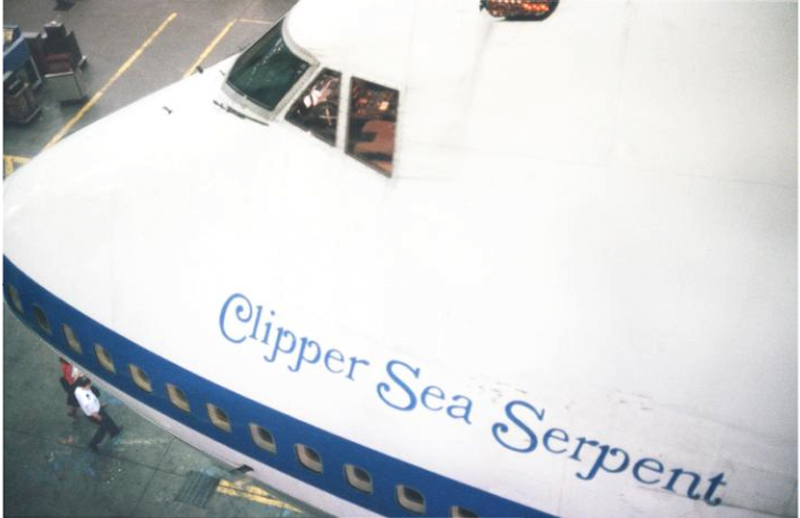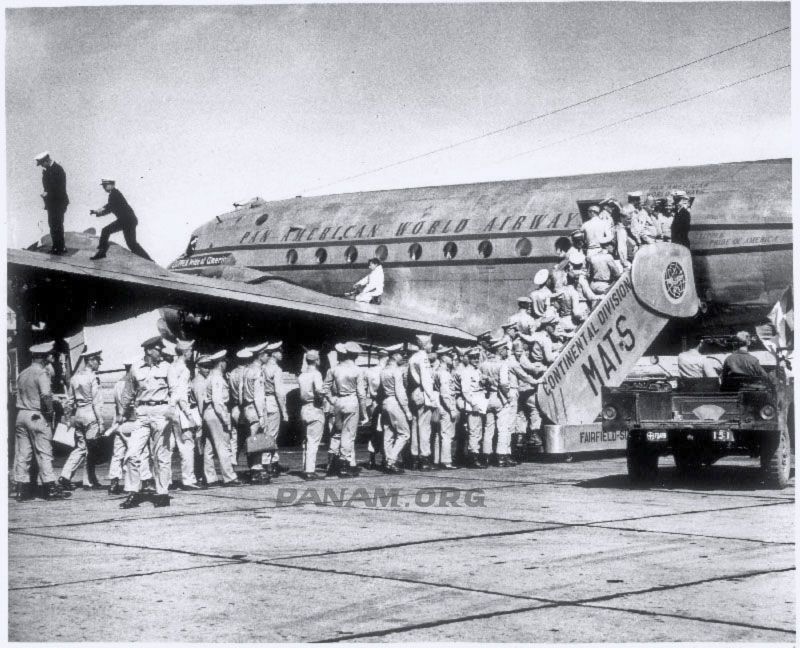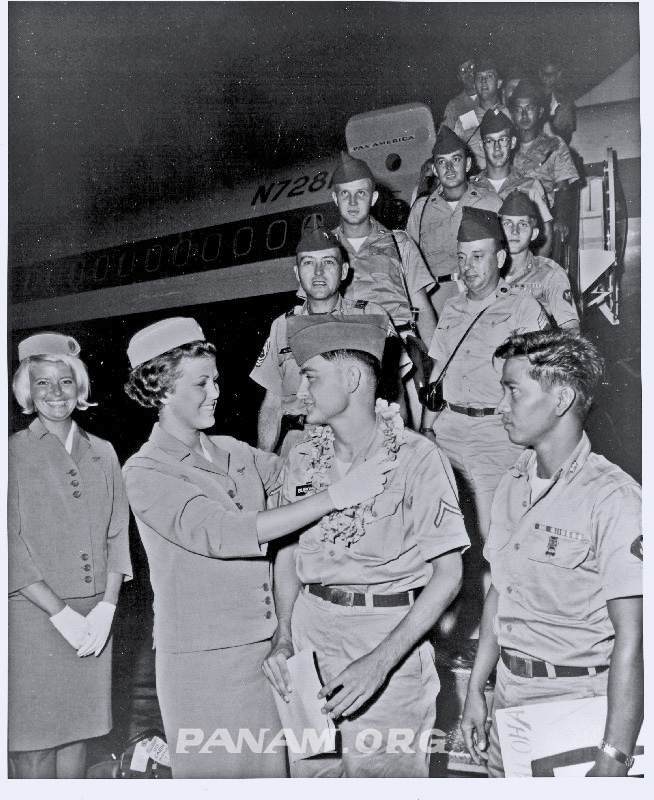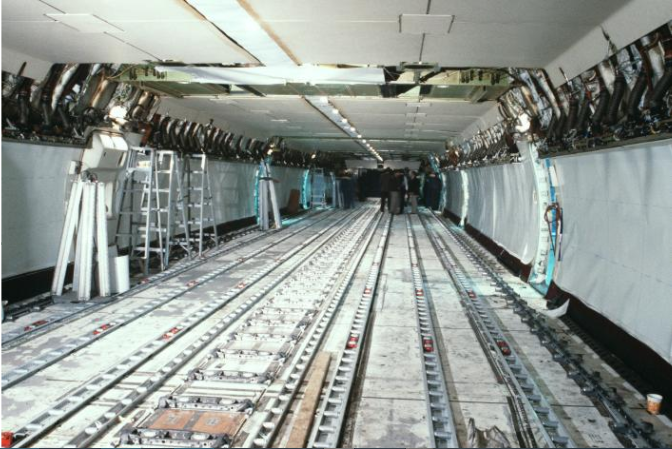AIRLIFT:
PAN AM AND THE CIVIL RESERVE AIR FLEET
 Pan Am B-747 Clipper Sea Serpent prepares to undergo modification at JFK for for use as an air ambulance in the event of war
Pan Am B-747 Clipper Sea Serpent prepares to undergo modification at JFK for for use as an air ambulance in the event of war
(Photo: National Archives and Records Administration, March 1986)
“General, the airlines are ready!”
-- Edgar Gorrell, president of the Air Transport Association to General George Marshall, September, 1939
Even before December 7, 1941, America’s airlines were ready to cooperate with the national government when asked. The need to get supplies and people to where they are needed in times of emergency has often demanded using the combined airlift capacity available to military and civilian airlines working together.
Pan American Airways passed from the scene as an operating carrier in December, 1991 – only days shy of the half-century mark since the attack on Pearl Harbor galvanized the nation into a war footing. For all those years, when “Uncle Sam” called, “Pan Am was there” – and was arguably the most involved US airline providing airlift services to the US government.
The organization behind this public-private cooperation has taken various forms over those years. Since the early 1950’s, the arrangement has been known as the CRAF. or Civil Reserve Air Fleet. Even though Pan Am is no longer a part, its symbolic legacy survives in the arrangement.
Beginnings
In January 1951 John A McCone, Assistant Secretary of the Air Force (and future CIA Director under John Kennedy), and members of the Civil Aeronautics Board held a meeting in Washington DC with representatives of the nation’s air carriers. Of course, Pan American World Airways was represented.
The purpose was to explore long-term organization for government use of civilian air transport. What would emerge was a plan for military contracts of civilian airliners and personnel in times of national need. Recent events had thrown a spotlight on the idea, but it was also the result of long experience learned over the course of years of managing commitments during war and peace. A great deal of that was thanks to Pan American.
During the months leading up to Pearl Harbor, Pan Am had been tasked by the Roosevelt administration to strengthen our defenses in preparation for war. Pan Am secretly built airports in Latin America and Africa, had ferried aircraft to British armed forces fighting the Axis powers, and was helping to keep China in the fight against Japan with air transport services by CNAC (a mission that turned deadly more than once). After America’s entry into the war, the military had desperately needed civilian airlift capabilities. The Naval Air Transport Service (NATS) and the Air Transport Command (ATC) were created as a result. NATS in particular owed a great deal to Pan Am. It was the brainchild of Clarence “Dutch” Schildhauer, recalled to active naval duty after Pearl Harbor, who had been instrumental in Pan Am’s transoceanic pioneering. By war’s end, Pan Am had completed 15,000 ocean crossings on US government business – far more than any other American civilian airline.
This 1944 promotional film shows NATS at work posted on YouTube by San Diego Air & Space Museum. A great many of NATS’ personnel were Pan Am’ers working under government contract and Navy Department orders.
Trouble viewing? Go to https://www.youtube.com/watch?v=bitozT3QNb8
These military organizations, which amalgamated civilian and military resources proved vital in moving cargos and people across the globe. Many of the operational techniques they successfully adapted were learned from Pan American.
A case in point was the “Hump” airlift across the Himalayas linking China and India, which Pan Am’s subsidiary CNAC had begun, and was later joined by the Army’s ATC. The ATC’s commanding officer for the operation by war’s end was Gen. William Tunner. His leadership and skills proved valuable later on, when he headed commands for the Berlin Airlift and then again during the Korean War, when thousands of troops and masses of supplies and equipment were ferried across the ocean.)
“It’s our job in war and we must practice it in peace.”
--Maj. Gen. Robert Webster, Commander of the ATC, January 1947
In immediate post-war days, America’s strategists began to fully grasp that the nation’s new global reach and power needed an airlift capacity to match. The armed services took a big stride towards more effective organization with the creation of the Military Air Transport Service, or MATS, on June 1, 1948, which merged the old wartime Navy and ATC airlift operations. That proved to be great timing, because just over three weeks later, MATS transports were thrown into “Operation Vittles” – the Berlin Airlift.
That massive operation lasted almost a year, until May of 1949, and proved how essential it was to tap all available airlift resources, both military and civilian, when the job called for it. American Overseas Airlines, a civil carrier (and soon to become a part of Pan Am), was effectively drafted into the military operation to keep Berlin alive. And it was only a year later that another challenge was handed to America’s national airlift strategists when North Korea launched an invasion of South Korea, on June 25th, 1950. This new crisis created an immediate need to get personnel and cargo to Asia, and quickly outstripped MATS’ capacity.
As before, Pan Am took the lead. President Juan Trippe announced on July 20, 1950 that PAA had immediately assigned equipment and personnel to aid the Korean airlift at the start of hostilities the month before. Pan Am had dedicated ten four-engined Clippers to the job. The company, which by now included American Overseas Airlines (AOA), provided substantial resources for the new mission. Trippe put AOA’s Harold R. Harris in charge of the new operation. And just a month later, Henry Kristofferson, veteran Pan Am pilot and executive, who had helped organize Pan Am Africa and the “Hump” airlift during the war, was called back to active duty – and a promotion to the rank of general - with MATS. Trippe indicated that Pan Am’s planes had been involved even before any government contracts had been signed, although those were soon in place (along with those for several other US airlines that provided crews and aircraft.)
The military’s own airlift efforts were hampered by aircraft utilization rates, in large part as a result of crewing challenges – and navigators in particular. But the civilian airlines could provide multiple crews for each plane, assuring more efficient utilization. This was something MATS was not able to manage without lengthy lead times. By contrast, by August 1950, Pan Am had 27 aircraft operating in the Pacific airlift, of which only ten were from PA’s own fleet. The balance were leased from other US airlines, but crewed by PA crews. Veteran pilot Basil Rowe was in put in charge of field operations.

Soldiers board Clipper Pride of America at Travis AFB, 1951
By the middle of 1952, the Pacific airlift had racked-up huge accomplishments. The military-civilian effort had made 11,000 round trips from the West Coast to Japan, and carried 343,000 passengers – 48,000 of whom were wounded servicemen coming home from Korea.
A Korean War vintage film provides some idea of how the Pacific Airlift worked. Seaboard and Western Airline was flying under government contract.
Trouble viewing? Go to https://www.youtube.com/watch?v=SRvsaA-GV0A
Airlift Politics
It was obvious in practical terms that when national priorities called for massive air transport in an emergency, the country would manage it a lot better with the cooperation of commercial airlines. On December 15, 1951 Defense Secretary Robert Lovett and Commerce Secretary Charles Sawyer agreed to an official plan, to be known as the Civil Reserve Air Fleet – or CRAF. From that day to this, the Civil Reserve Air Fleet has been included as a contingency in government plans.
But CRAF as a working arrangement has always had issues, both in theory and practice. It’s been an evolving, complex organizational challenge, which has had to adapt to a range of real-world realities, such as Pentagon-required modifications for civilian airplanes, and political demands. These latter have usually focused on economic issues.
In actual practice, call up of CRAF participants as a matter of national emergency has happened only twice (more about that later). But military contracts for civilian airlift missions happen all the time, under arrangements that have varied due to shifting priorities. The military is expected to be ready to carry out whatever mission they are tasked with. The nation’s airlines are sensitive to economic factors – and among these unfair competition from government is high on the list. When government contracts for military airlift missions are not available because the military can carry them out, the airlines have often objected – and Congress has often responded by pressuring the Department of Defense to act accordingly.
There are inherent differences between the nature of military operational considerations – usually it’s a matter of “maximum effort” – and the commercial airline business. For them it’s a matter of maximizing efficiency, economy, and convenience. On the military side, problems often revolve around training and availability of personnel and equipment, while the airline business seeks a return on investment and making best and efficient use of aircraft and people. And the inherent competition between public and private enterprises being tasked with same job has been the source of continual organizational review, debate, and realignment, particularly on the military side. The Department of Defense contracts with US commercial airlines as an incentive to keep them “on point” for potential military missions, but the airlines have often complained that they are competing with the military for government air transport business.
Civilian pressure led to the diminishing of the role of MATS, which was seen as taking food off of the civilian airlines’ table. And by the end of the 1950’s, spurred by Pan Am’s purchase of 25 jet transports, the airline industry rushed to enlarge its capacity, putting more pressure on the government to reduce its own airlift activities.
The Vietnam War provided an immense, but limited stimulus to civilian airlift use by the military. In 1966, there were six civilian contract airlines doing the work. Two years later, there were a total of 23. Pan Am had the largest commitment to the CRAF during the 1960’s, topping out in 1969 with 104 aircraft registered for the program, followed by TWA with 46, United with 40, and Northwest with 36 aircraft, respectively that year, which saw a total of 330 aircraft available for use in CRAF operations. Those civilian airlines carried over 90% of the passenger traffic and almost one-quarter of the cargo for Uncle Sam.
Another very important mission carried out by Pan Am during the Vietnam War were the R&R flights provided to American Service Members. Thousands were carried on Pan Am flights to Hong Kong, Tokyo, and elsewhere. For the first months of the service, the flights were provided to the nation at a cost of $1 per month.

Pan Am R&R flight arrives in Hawaii during the Vietnam War
After American involvement in Vietnam wound down, once again there was grumbling among civilian air carriers that the Pentagon’s air transport arm – now minus US Navy components and renamed the Military Airlift Command (MAC) – was improperly operating services that should be contracted out to civilians. It was also the advent of the B-747 era, which meant a substantial increase in (and underutilization of) capacity in civilian fleets. This was just at a time when government contracts for airlift missions were on the decline.
But the basic strategy for CRAF remained in place as the years rolled by. For example, in 1978 when European NATO leaders wanted to know what the US was doing about perceived new Soviet military threats, Defense Secretary Harold Brown could reassure them that between American military and civilian airlift capabilities, American troop strength in Europe could be doubled in a matter of days.
A 1977 US Air Force film explains CRAF, with generous references to Pan Am’s involvement over the years.
Trouble viewing? Go to https://www.youtube.com/watch?v=aUBZUw1rfmg
Throughout the 1970’s, both military and civilian airlift capacity increased, as wide-body, heavy-lift aircraft came online. By 1980, the CRAF airlift capability reached a staggering fifteen million ton-miles per day, and the military fleet had grown too. At that point, Pan Am still held the lead in numbers of CRAF aircraft with 74, while Northwest (with 51) and TWA and American (42 each) followed up. In the next decade, the government and Pan Am reached an accord to specially modify some of the airline’s older B-747’s to handle cargo and passengers. Pan Am was the only airline to do this.
Modifications of Pan Am 747 Sea Serpent at JFK, March 1986. Photos from National Archives and Records Administration.
But winds of change were blowing through the airline business. Deregulation, which came into force in the early 1980’s, put new pressures on America’s air carriers. Competition meant sharply reduced margins, and airlines responded in part by reducing their fleets. This trend meant fewer aircraft to quality for the CRAF, so the government began to look further afield for solutions, such as trying to mandate design modifications on new aircraft to comport with military airlift specifications. The airlines were dead set against that. Another strategy was to seek out new CRAF candidate carriers among express shippers such as FedEx.
As far as Pan American and the CRAF program were concerned, the appropriate final chapter came with the Gulf War in 1990/91. Even before the call up came from the US government, Pan Am and a handful of other carriers volunteered their crews and aircraft to get American troops to the Middle East. When the official call came in August 1990 for Operation “Desert Shield,” Pan Am supplied three aircraft (as did Northwest). That official call was the very first time that the CRAF system had been officially put to the test in an emergency, and it worked without a hitch. When the operation ended in May, CRAF aircraft had completed 5,400 missions, carrying 60% of the passengers and 25% of the cargo. It was the first and last time Pan Am would ever be involved in a CRAF call-up, but given the long history of the airline’s involvement with government work, it seems fitting that “America’s most experienced airline” was there.
One final note: the CRAF was activated again in 2003, in support of Operation “Iraqi Freedom” – but of course this time, without Pan Am.

















